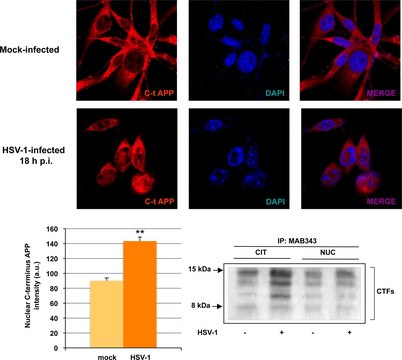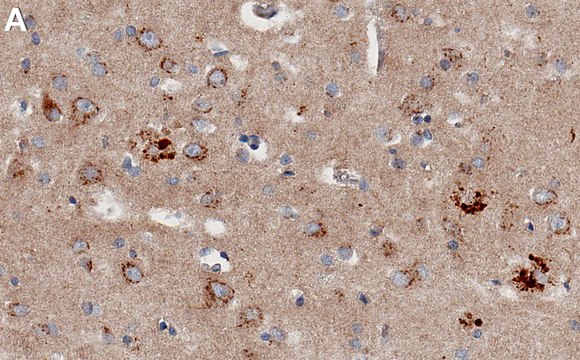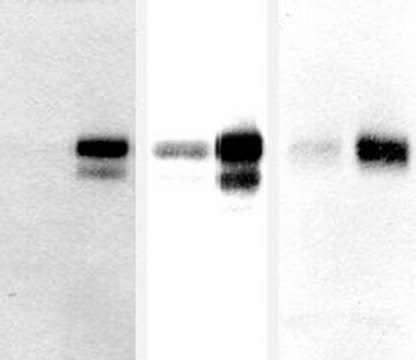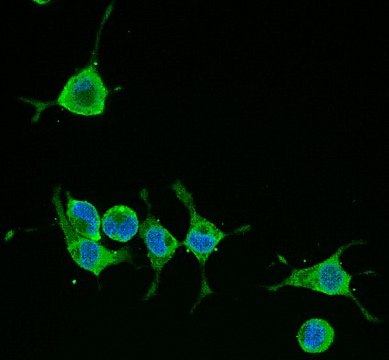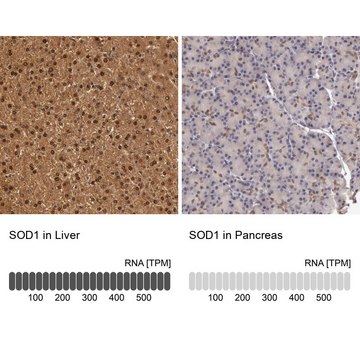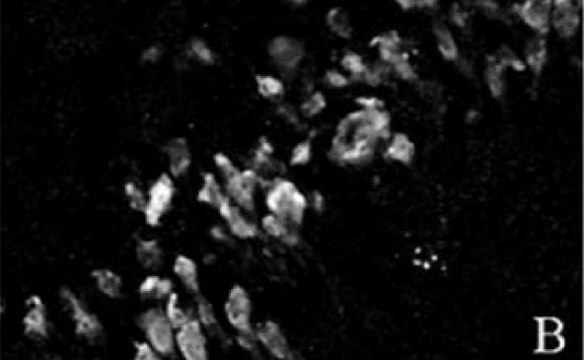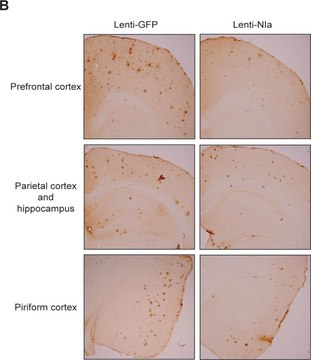IHCR1002-6
Anti-APP A4 Antibody, a.a. 66-81 (NT), Prediluted, clone 22C11
clone 22C11, Chemicon®, from mouse
Sign Into View Organizational & Contract Pricing
All Photos(1)
Synonym(s):
APP
UNSPSC Code:
12352203
eCl@ss:
32160702
NACRES:
NA.41
Recommended Products
biological source
mouse
Quality Level
antibody product type
primary antibodies
clone
22C11, monoclonal
species reactivity
canine, mouse, monkey, pig, fish, human, rat
manufacturer/tradename
Chemicon®
technique(s)
immunohistochemistry: suitable (paraffin)
isotype
IgG1
NCBI accession no.
UniProt accession no.
shipped in
wet ice
target post-translational modification
unmodified
Gene Information
human ... APP(351)
General description
Deposits of amyloid protein in senile plaques near nerve processes are found in the brains of aged humand and cases of Alzheimer′s Disease. The principle component of this extracellular amyloid is beta/A4, a 4 kDa peptide derived from a larger amyloid precursor protein (APP), which is widely expressed in the brain and body. The creation, transport and function of these proteins are currently under investigation Reacts with pre-A4.
Specificity
The antibody recognizes amino acids 66-81 of the N-terminus on the pre-A4 molecule (Hilbich et al., 1993). 22C11 recognizes all three isoforms of APP, immature ~110kDa, sAPP ~120kDa, and mature ~130kDa (Hoffmann et al., 2000). The antibody is known to cross react with APLP2 (Slunt, 1994).
Immunogen
Epitope: a.a. 66-81 (N-terminus), Prediluted
Purified recombinant Alzheimer precursor A4 (pre A4695) fusion protein.
Application
Antibody is prediluted and ready to use for Immunohistochemistry of formalin-fixed, paraffin-embedded tissues.
Pretreatment: Heat Induced Epitope Retrieval (HIER). Recommend Citrate Buffer, pH 6.0 (Cat. No. 21545). No signal was detected without Epitope retrieval.
Incubation: 30 minutes with IHC Select Detection Kits.
App has been prediluted for use as the primary antibody with Chemicon′s IHC Select Detection Kits and Protocols (Catalog Nos. DAB050, DET-HP1000, APR050, and DET-APR1000), but other supplier′s IHC detection systems may be used. For optimized protocol details, visit www.chemicon.com and select the protocols link under Cat. No. IHCR1002-6.
Pretreatment: Heat Induced Epitope Retrieval (HIER). Recommend Citrate Buffer, pH 6.0 (Cat. No. 21545). No signal was detected without Epitope retrieval.
Incubation: 30 minutes with IHC Select Detection Kits.
App has been prediluted for use as the primary antibody with Chemicon′s IHC Select Detection Kits and Protocols (Catalog Nos. DAB050, DET-HP1000, APR050, and DET-APR1000), but other supplier′s IHC detection systems may be used. For optimized protocol details, visit www.chemicon.com and select the protocols link under Cat. No. IHCR1002-6.
Detect Alzheimer Precursor Protein A4 using this Anti-APP A4 Antibody, a.a. 66-81 (N-terminus), Prediluted, clone 22C11 validated for use in IH(P).
Research Category
Neuroscience
Neuroscience
Research Sub Category
Neurodegenerative Diseases
Neurodegenerative Diseases
Physical form
Format: Purified
Liquid diluted in PBS, pH 7.2 with stabilizers, 0.2% Tween 20, and 0.1% Kathon as preservative.
Storage and Stability
Maintain at 2-8°C. Refer to vial for expiration dating.
Legal Information
CHEMICON is a registered trademark of Merck KGaA, Darmstadt, Germany
Disclaimer
Unless otherwise stated in our catalog or other company documentation accompanying the product(s), our products are intended for research use only and are not to be used for any other purpose, which includes but is not limited to, unauthorized commercial uses, in vitro diagnostic uses, ex vivo or in vivo therapeutic uses or any type of consumption or application to humans or animals.
recommended
Product No.
Description
Pricing
Signal Word
Warning
Hazard Statements
Precautionary Statements
Hazard Classifications
Aquatic Chronic 3 - Skin Sens. 1
WGK
WGK 2
Flash Point(F)
Not applicable
Flash Point(C)
Not applicable
Certificates of Analysis (COA)
Search for Certificates of Analysis (COA) by entering the products Lot/Batch Number. Lot and Batch Numbers can be found on a product’s label following the words ‘Lot’ or ‘Batch’.
Already Own This Product?
Find documentation for the products that you have recently purchased in the Document Library.
Edward Rockenstein et al.
The Journal of biological chemistry, 280(38), 32957-32967 (2005-07-20)
Amyloid-beta peptides (Abeta) are widely presumed to play a causal role in Alzheimer disease. Release of Abeta from the amyloid precursor protein (APP) requires proteolysis by the beta-site APP-cleaving enzyme (BACE1). Although increased BACE1 activity in Alzheimer disease brains and
Our team of scientists has experience in all areas of research including Life Science, Material Science, Chemical Synthesis, Chromatography, Analytical and many others.
Contact Technical Service
